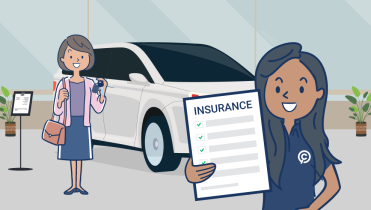less than
2 mins
- Home
- Personal Finance
- Guide
- Car Insurance for Learner Drivers
Car Insurance for Learner Drivers
Key Points
You’re legally required to take out Compulsory Third Party (CTP) car insurance before you can register your car on the road in Australia.
If a learner driver is likely to use your car, ensure they’re included in your insurance policy, even if this raises your premium.
A learner driver with their own car will need to take out their own car insurance policy.
Learner drivers may be charged one or more excess premiums on top of their standard one, but not all insurers do this.
In Australia, individuals can apply for a learner’s permit from the age of 16. Learner drivers are considered a high-risk age group of drivers, resulting in higher car insurance premiums. It’s common for learners to be charged an "age excess" due to this additional risk.
Compare & SaveConsider your options carefully when choosing the type of insurance that best suits your needs and circumstances. It’s a good idea to familiarise yourself with the different types of car insurance available to new drivers:
Compulsory third party (CTP) insurance is legally required in Australia and provides compensation for injuries or fatalities resulting from accidents involving your vehicle. It doesn’t cover damage to your car or any other property. If you accidentally sideswipe another car, any damage to people is covered - but not the other car, or yours.
Third party property car insurance covers the repair costs for damages to another person’s property. So, this insurance does cover your sideswipe - but doesn’t include cover for your vehicle. Some policies may include fire and theft protection.
Comprehensive car insurance offers you and your car the most extensive protection, covering damage done to your car, damage to other people's property, and the theft or loss of your car.
How does car insurance work for learner drivers?
While keeping your learner driver off your car insurance policy may seem like a good idea for keeping your premium down, if your L-plater is involved in an accident while driving your vehicle, this can cost you a lot more. There are generally two options for insuring L-platers:
Add your L-plater to your existing policy: If your child is learning to drive in the family car, adding them to your current insurance policy is an option. Some policies may automatically cover learners, but it's important to check the Product Disclosure Statement (PDS) for confirmation.
Take out a separate policy: If you’re the L-plater and you have your own vehicle, a new car insurance policy listing you as a regular driver may be necessary.
Getting car insurance for learner drivers on parents' cars is often more cost-effective than purchasing a stand-alone policy. When it comes to insurance for learner drivers in their own car, a comprehensive car insurance policy is recommended for maximum protection. Third-party insurance may be suitable for low-value cars.
Can a Learner Driver Own and Insure Their Own Car?
Yes, you can still own and insure your own car as a learner driver, though your premium might be high. If the car is registered to you though, you will need your own insurance policy.
How Much is Car Insurance for a Learner Driver?
This depends a lot on your insurer, and whether you’re adding your learner driver to your policy, or they’re buying their own. Shopping around for car cover means getting familiar with the ins and outs of car insurance, including cover limits, premiums, and excesses involved.
Compare & SaveUnderstanding your car insurance excess as a Learner Driver:
Understanding insurance excess is important for learner drivers, and for their parents or guardians. There are various types of excess that might apply to your policy or a learner driver's policy. These can include:
Standard/Basic Excess: This fundamental excess applies to your car insurance policy, regardless of the named driver.
Age Excess or Younger Driver Excess: An additional excess applied to drivers under 25 years of age.
Learner Driver Excess: L-platers may face a specific excess. This depends on your insurer, and your specific car insurance policy.
Inexperienced Driver Excess: This applies to learner drivers over 25 with limited driving experience, and can cost more than your standard excess.
Undeclared Driver Excess: Charged if a learner driver, not previously declared, is involved in an accident. This additional charge can be expensive.
Car Excess: An additional excess based on the type or age of your vehicle. For example, if it’s a vintage, or otherwise specialised model of car.
Voluntary Excess: This is where you might agree to a higher excess in order to receive a lower annual car insurance premium.
Choosing the Right Insurance:
To ensure optimal coverage and value for money, research your car insurance, and your insurer, thoroughly. Consider additional benefits you might want to include, such as:
after-accident care,
repair conditions,
windscreen cover,
rental vehicle cover,
Tips to Reduce Your Premiums:
Increase your excess to lower your premium.
Explore available discounts such as loyalty discounts or multi-policy discounts.
Consider different premium payment frequencies.
Keep your car well-serviced.
Park it securely whenever you can.
Keep your driving record as unblemished as possible.
Conclusion
Whether you’re a new road user, or a parent/guardian of one, understanding the insurance options available to learner drivers in Australia can help you make informed decisions about your car cover.
Both adding a learner driver to an existing policy or helping them get a brand new one to match their first car, are essential steps in ensuring you’re protected on the road.
Sources
Road Safety NSW: Serious Injuries 2022
Road Safety NSW: Trauma Trendsdit.sa.gov.au - young drivers & road safety fact sheet
Things You Should Know
Compare Club Car Insurance is an online financial comparison service and is owned and operated by Compare Club Australia Pty Ltd (ACN 634 600 007). Compare Club does not compare all brands or all products offered by all brands.
The financial products compared on this website do not necessarily compare all features that may be relevant to you. Please check with a financial professional before you make any major financial decisions.
Any advice given here is general and has been prepared without considering your current objectives, financial situation or needs. Therefore, before acting on this advice, you should consider the appropriateness of the advice having regard to those objectives, situation or needs.
You should consider the insurers PDS prior to making the decision to purchase their product. For more information please read our Financial Services Guide (FSG) which contains further information about how our service works and how we make money.
Paul Coughran is the General Manager of Emerging Verticals at Compare Club. Paul has over 20 years of experience across a wide range of industries including Banking and Finance, Telecommunications and Energy. Paul leads a team of trusted experts dedicated to helping individuals make informed decisions about their insurance and utilities needs.

Meet our car insurance expert, Paul Coughran
Paul's top car insurance tips
- 1
Regularly compare your insurance policies – You could be paying for cover you don’t need. Shopping around every so often can save you a fair bit, maybe even hundreds each year.
- 2
Don’t just look at the premium—check the excess too. While a higher excess might bring down your premium, remember you’ll have to fork out more if you do need to claim.
- 3
Double-check what’s included in your policy. Extras like windscreen cover or roadside assistance might not be part of the deal and could cost you more.
- 4
If you don’t drive much, consider usage-based insurance. Some policies base your cost on how much you actually drive, if you work from home or only use your car for short trips this might be a much better option.


